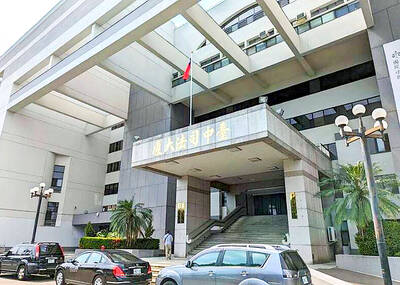National Chung Hsing University (NCHU) researchers have discovered certain genes in orchids that can be used to manipulate flower hue, prolong the flowering period and prevent wilting, which could reduce the time needed to produce new orchid varieties from seven years to two months.
There are more than 28,000 varieties of orchids, making them one of the largest and most diverse families of flowering plants, NCHU vice president and Graduate Institute of Biotechnology professor Yang Chang-hsien (楊長賢) said on Wednesday.
The popularity of orchids lies in their flowers, which are defined by a symmetrical perianth — the non-reproductive elements of the flower — separated by a distinct petal called the lip or labellum that attracts insects, he said.

Photo: Su Meng-chuan, Taipei Times
Five years ago, a research team led by Yang developed the “perianth password” theory, which discovered the L and SP complexes behind orchid petal formation.
The SP complex determines sepal and petal formation, while the L complex determines the identity of the lip.
In a paper published on Feb. 10 in Nature Communications, the team said that the SP complex not only moderates sepal and petal formation, but also pigmentation, deterioration, shedding and other life cycle processes.
Three of the genes involved in the creation of the SP complex can change the color of the flower, Yang said.
These proteins can be suppressed through gene silencing to reduce anthocyanin — or pigment — accumulation, in effect bleaching the flower, he said.
He provided two samples, one of a purple-red moth orchid that became significantly whiter after intervention, and the other of an orange moth orchid that became yellow.
Also using gene silencing, other proteins in the SP complex can be suppressed to make the flowers age or the stem harden prematurely, ensuring that the flowers do not fall off even when withered, Yang said.
It takes seven to eight years to cultivate new types of orchids through relatively unpredictable cross-breeding, but with this method, a new color could be produced in as little as two months, he said.
The flowering period could also be stretched longer than the standard 80 to 100 days, he added.
Yang said the discovery refutes the assumption that the genes governing flower formation retreat after the floral organs are formed, showing that these mechanisms remain important in other stages of flower development.
The finding is a breakthrough in the field of international flower research, he said.
It also has practical implications, as the technique can increase the output diversity and value of the domestic orchid market, he added.
Other article authors include NCHU postdoctoral researchers Hsu Hsing-fun, Chen Wei-han, Hsu Wei-han and Mao Wan-ting, as well as master’s degree student Shen Yi-hsuan.

The first global hotel Keys Selection by the Michelin Guide includes four hotels in Taiwan, Michelin announced yesterday. All four received the “Michelin One Key,” indicating guests are to experience a “very special stay” at any of the locations as the establishments are “a true gem with personality. Service always goes the extra mile, and the hotel provides much more than others in its price range.” Of the four hotels, three are located in Taipei and one in Taichung. In Taipei, the One Key accolades were awarded to the Capella Taipei, Kimpton Da An Taipei and Mandarin Oriental Taipei. Capella Taipei was described by

EVA Airways today confirmed the death of a flight attendant on Saturday upon their return to Taiwan and said an internal investigation has been launched, as criticism mounted over a social media post accusing the airline of failing to offer sufficient employee protections. According to the post, the flight attendant complained of feeling sick on board a flight, but was unable to take sick leave or access medical care. The crew member allegedly did not receive assistance from the chief purser, who failed to heed their requests for medical attention or call an ambulance once the flight landed, the post said. As sick

The Taichung District Court yesterday confirmed its final ruling that the marriage between teenage heir Lai (賴) and a man surnamed Hsia (夏) was legally invalid, preventing Hsia from inheriting Lai’s NT$500 million (US$16.37 million) estate. The court confirmed that Hsia chose not to appeal the civil judgement after the court handed down its ruling in June, making the decision final. In the June ruling, the court said that Lai, 18, and Hsia, 26, showed “no mutual admiration before the marriage” and that their interactions were “distant and unfamiliar.” The judge concluded that the couple lacked the “true intention of

INDUSTRY: Beijing’s latest export measures go beyond targeting the US and would likely affect any country that uses Chinese rare earths or related tech, an academic said Taiwanese industries could face significant disruption from China’s newly tightened export controls on rare earth elements, as much of Taiwan’s supply indirectly depends on Chinese materials processed in Japan, a local expert said yesterday. Kristy Hsu (徐遵慈), director of the Taiwan ASEAN Studies Center at the Chung-Hua Institution for Economic Research, said that China’s latest export measures go far beyond targeting the US and would likely affect any country that uses Chinese rare earths or related technologies. With Japan and Southeast Asian countries among those expected to be hit, Taiwan could feel the impact through its reliance on Japanese-made semi-finished products and